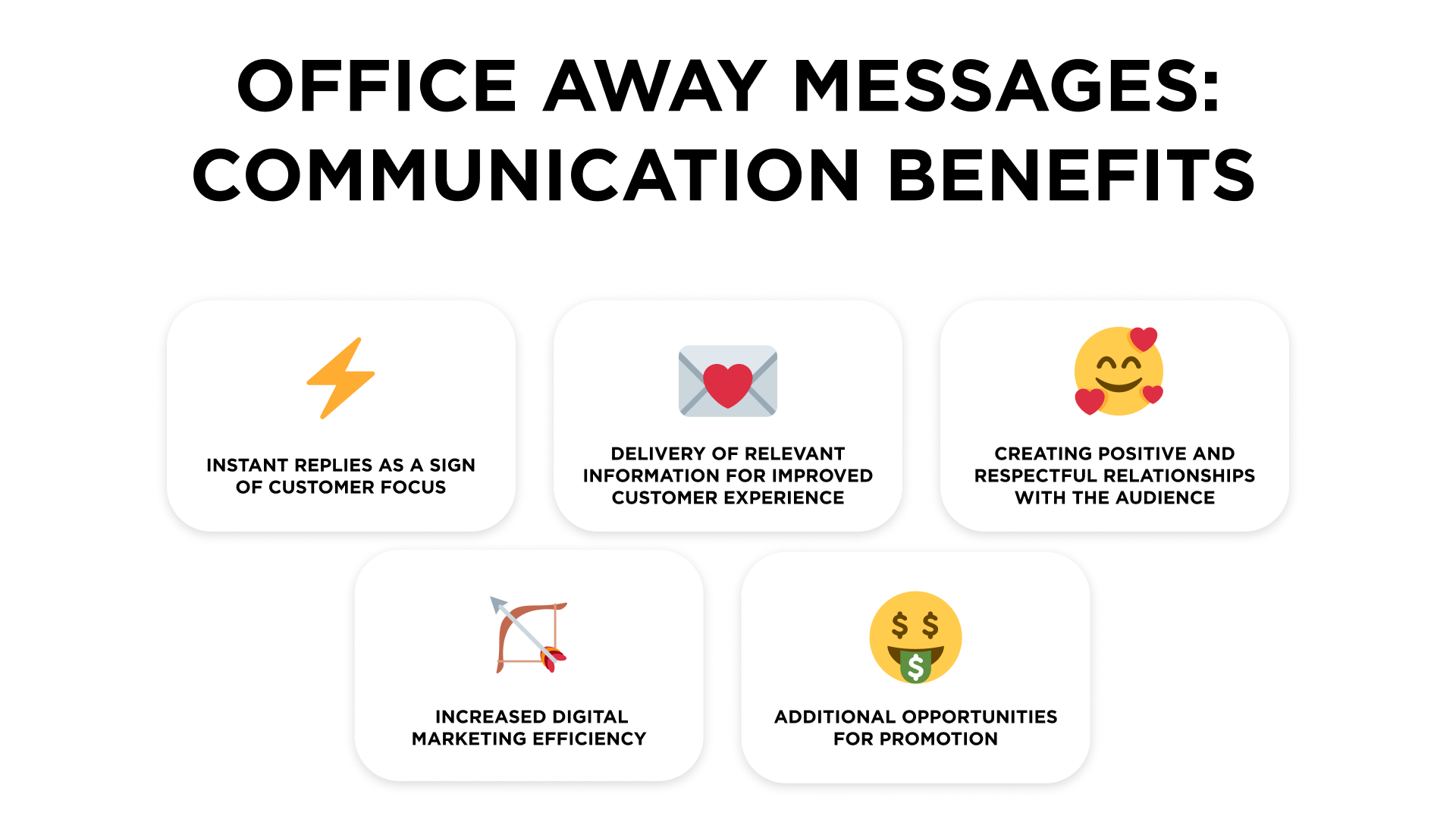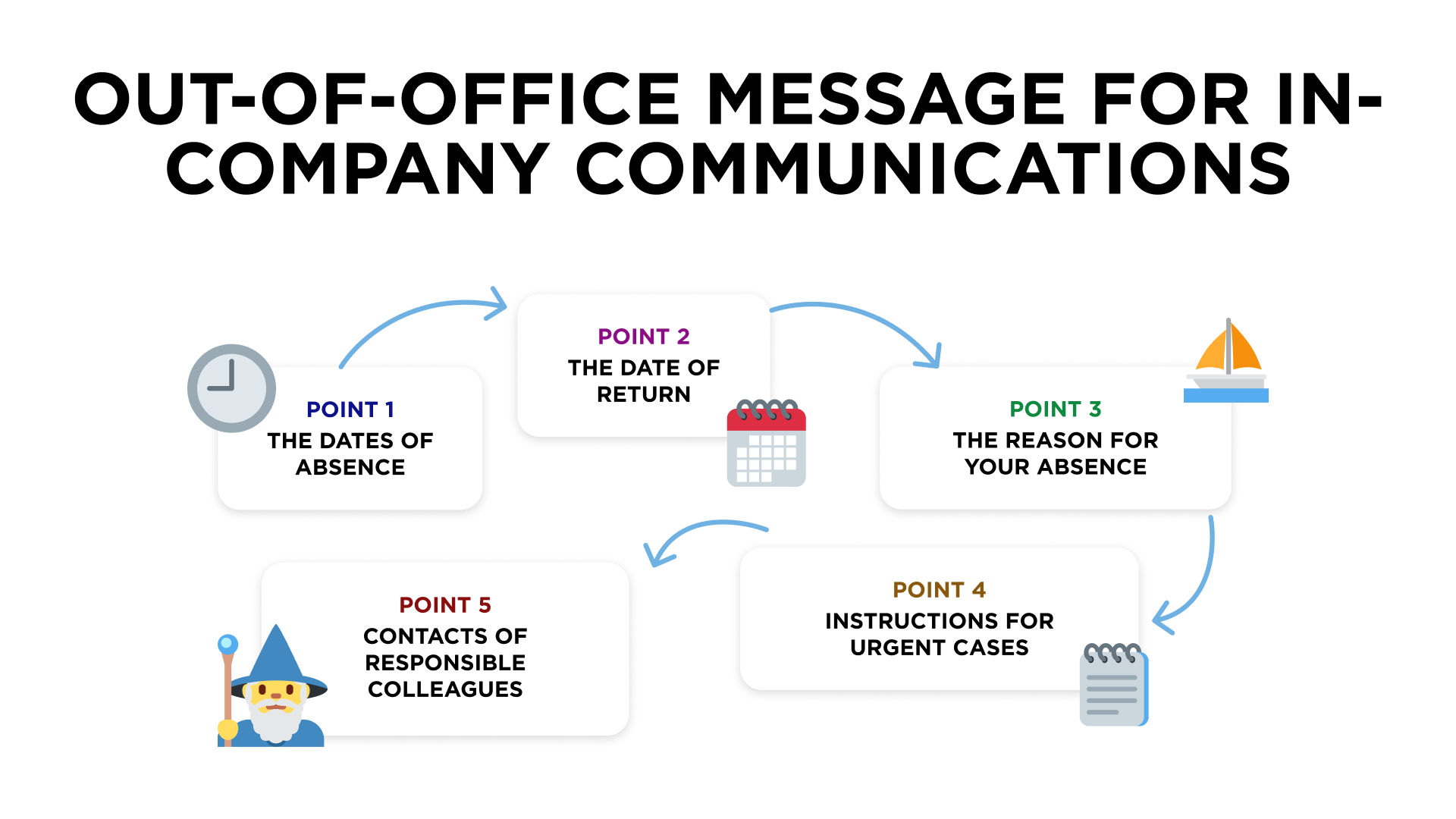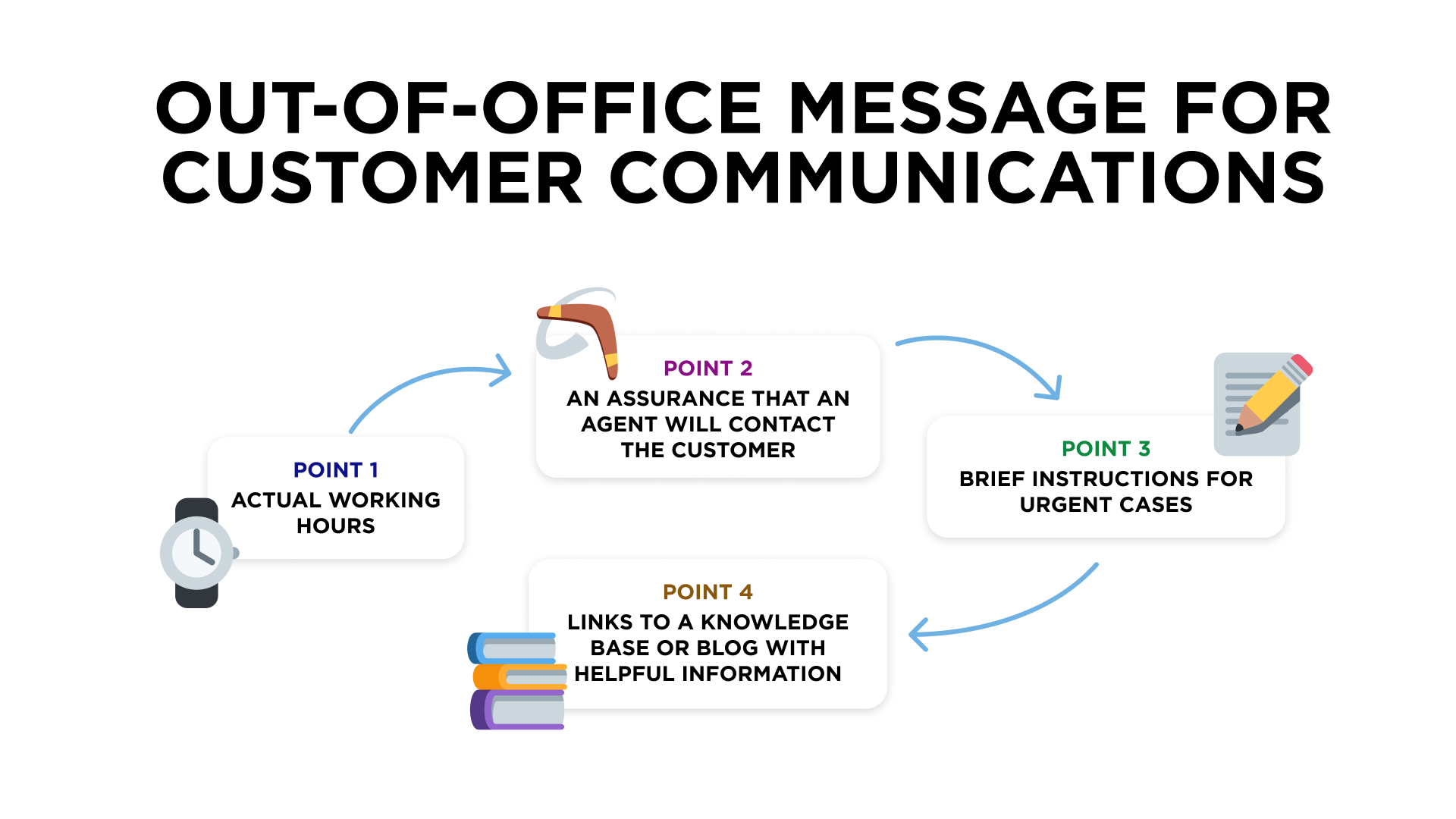Message Mastery: Writing Out-of-Office Messages That Work for You
Learn how to notify about your absence professionally and turn office-away messages into an opportunity for brand promotion.

In the fast-paced world of professional and customer communication, a simple out-of-office message can be more than just a courtesy. It turns into a strategic tool to enhance your workflow and leave a lasting impression. In this article, we uncover the potential behind those brief auto-replies. From understanding the basics of crafting compelling messages to exploring examples that resonate, we'll delve into the importance and benefits of elevating your out-of-office game. Get ready to transform your absence into an opportunity for connection and professional finesse.
The significance of clear out-of-office messages
Out-of-office or office-away messages are automated responses you set up in an email system or messengers to inform senders that you are currently unavailable. You can activate them for the period you will be away from work or unable to respond promptly.These messages convey information about the recipient's absence, provide alternative contacts for urgent matters, and set clear expectations for when the person will return and resume regular communication. Let’s take a closer look at the out-of-office mail and their importance.
Communication assurance
Leaving colleagues and clients in the dark during your absence can lead to uncertainty and potential disruptions. By stating the time people can reach you, you provide reassurance. This transparency fosters trust and reinforces a commitment to open communication channels. It sends a message that, despite being away, you prioritize responsiveness and are dedicated to maintaining a flow of information.
Avoiding misunderstandings
Clearly outlining what will happen if someone attempts to contact you while you're away helps manage expectations. Whether it's a delay in response time, redirection to a designated contact person, or an alternative communication method, setting the right expectations mitigates misunderstandings and prevents frustration on both ends. By addressing potential concerns proactively, you demonstrate professionalism and respect for others' time, even in your absence.
Keeping workflow smoothness
An out-of-office message is not just a formality; it's a safeguard for business continuity. By clarifying that while you're away, your colleagues are equipped to handle inquiries or urgent matters, you contribute to the seamless flow of business processes. Customers feel confident that their needs won't be neglected, ensuring that your absence doesn’t become their problem. This approach to business continuity reinforces your commitment to client satisfaction and preserves the dynamics of ongoing projects.
Clear options for further interaction
One more crucial aspect of a well-crafted out-of-office message is that it provides its recipient with a clear choice. They can choose to wait for your return, knowing that you'll address their questions upon your comeback. Otherwise, a recipient can opt to proceed without you, armed with the information about alternative contacts or expected delays. This empowers the person to make informed decisions, contributing to smoother workflows and minimizing potential delays in processes while you are away.
Advantages of relevant information and professional communication
When it comes to personal interactions between colleagues, it is difficult to underestimate the significance of office-away messages. They let others know the dates and reasons for the employee’s absence and provide necessary information on additional contacts for managing urgent cases.
However, in customer communication, office-away messages are no less important. Imagine you connect a free live chat to your website. In this case, website visitors can use it at any time, and if you don’t have a 24/7 support service, you cannot address all these inquiries instantly. And if potential customers don’t get an immediate response, you might be at risk of losing them. This is the reason for setting up out-of-office messages for customer communication channels, and now, we’ll dive into the advantages you can get from them.

Response time as a non-verbal sign
In the digital landscape, response time serves as a powerful non-verbal cue. When clients receive a prompt out-of-office acknowledgment, it communicates more than just unavailability—it signals the company's responsibility and professionalism. This swift acknowledgment assures clients that their messages matter and that the company is committed to efficiency and reliability, contributing to a positive perception of the business.
Customer-focused information
By elevating out-of-office messages from mere notifications to valuable resources, companies can provide relevant information. This includes details like working hours or directing customers to a knowledge base for issue resolution. By doing so, the company showcases a high level of customer focus, demonstrating a proactive approach to addressing customer needs. Empowering customers with the tools and information to resolve queries independently enhances their experience and reinforces the brand's commitment to customer satisfaction.
Valuing customers' time
Out-of-office messages, when crafted thoughtfully, convey a deeper message about the value placed on customers' time. Offering an instant response at any time, even if a direct interaction is not possible, becomes a crucial element of professional etiquette. This assurance not only acknowledges the customer's attempt to communicate but also emphasizes that their time is valued. It goes beyond mere responsiveness, fostering a positive and respectful relationship between the customer and the business. This sense of importance contributes significantly to brand loyalty and customer satisfaction.
Digital marketing impact
As out-of-office messages aren't confined to personal interactions, they extend their influence on your digital marketing results. A well-crafted message, aligned with your brand’s tone of voice, enhances customer engagement. It's an opportunity to leave a positive impression, showing that even in automated responses, your business demonstrates professionalism and attentiveness. Consistent messaging, whether in direct communications or automated replies, contributes to a cohesive brand image and reinforces the reliability of your brand.
Opportunities for promotion
Think of your office-away message as a subtle marketing tool. Beyond the standard details, use this space to provide a glimpse into your business. Share helpful materials from your blog, advice on the most popular options, or offer other beneficial options. This not only keeps your audience informed but also turns a routine auto-response into an opportunity to strengthen relationships and showcase more aspects of your business. By leveraging this space effectively, you transform a momentary absence into an opportunity for engagement and brand promotion.
However, to make all these advantages work for you, you need to consider one more point, especially if your business uses omnichannel communication. The point is that you should provide relevant information through all the channels and update it timely. Moreover, all communications should be aligned with your brand’s voice.
It might be complicated as various messengers and chats are managed by different agents. So it is crucial to unify communications through all channels, and the best way to do it is to use one platform that allows delivering conversations across all messengers and social media.
Key components for an out-of-office message
Though the main points for an office-away message don’t change, the structure can be different for various recipients.
In-company communications

For colleagues and business partners, it is crucial to know for how long and for what reasons you are absent, and contacts for urgent matters. So in this case, you should include the following points:
- The dates you will be away from the office and return.
- The reason for your absence.
- Brief instructions on how people should proceed without you and contact your responsible colleagues. Maybe particular projects require your attention, and for proceeding on these projects, colleagues and partners need to wait for you. You need to consider these details as they are crucial for the workflow.
- Points of contact for urgent cases: provide your colleagues’ names, job titles, phone numbers, and email addresses.
Customer communications

When interacting with customers, consider they probably don’t need to know why you are away from the office, out-of-office messages for them will include other information. It is essential to let customers know when you can get back to them and advise on further actions. Here, you need to mention the following:
- Working hours of chat agents or support specialists.
- An assurance that an employee will contact them during working hours.
- Brief instructions for urgent cases, such as an emergency phone number if you have one.
- Links to your knowledge base or blog where they can find an answer to their question.
Out-of-office message samples
Let's take a look at out-of-office message samples—practical examples that not only showcase effective communication but also serve as templates for crafting your own. Whether you're seeking inspiration or a ready-made blueprint, these samples can illustrate the balance between professionalism and personal touch. Feel free to use them as a starting point, tailoring the messages to fit your unique style and circumstance.
In-company communications
Sample 1
[Greetings]
Thank you for your message. Unfortunately, I'm out of the office [dates of absence] for [reason]. I will have no access to my email until [date of return].
During this time, I will be unable to respond to your message. If the request is urgent, please contact [name of colleague, their job title] at [email, phone]. Otherwise, I’ll get back to you as quickly as possible when I return.
I appreciate your understanding in the meantime.
[Closing and signature]
Sample 2
[Greetings]
I will be out of the office [dates of absence] for [reason]. I won't have access to my inbox and will be unable to respond to your message until [date of return].
If you need immediate assistance, please contact [name of colleague, their job title] at [email, phone]. Otherwise, I will respond to your emails as soon as possible upon my return.
[Closing and signature]
If there are any special details such as projects that cannot be proceeded without you, you should also mention them in the message as a part of instruction.
Customer communications
When setting up an office-away message for clients, you need to consider the channel of communication. Let’s take email for the first example and a chat widget for the second one.
Sample 1
[Greetings]
Thanks for getting in touch with [company name]! Unfortunately, we cannot reply to you right away.
Our working hours are [indicate time], and we will get back to you as soon as we are open.
In the meantime, please check out our knowledge base to address your inquiry: [link to the help center or blog]
Thank you for your understanding!
[Closing]
Sample 2
Hi! Thanks for contacting [company name]. Our operating time is [indicate time], and we will get back to you during business hours. Please check out our help center for an instant solution: [link to the knowledge base or blog]
You can add an emergency phone number, a link to FAQ, or links to popular lists and articles, depending on the most frequent customers’ inquiries.
Summing up
An out-of-office message, when mastered, becomes more than an absence note—it's a testament to your message mastery in the professional field. As you craft your messages, remember the balance: professionalism with a touch of personality. Whether assuring responsiveness, mitigating misunderstandings, or showcasing your business, each element contributes to impactful communication.
Take the most of message automation: if your business has multiple channels of customer communications, consider using an omnichannel messaging platform such as Umnico Inbox. It can help you maintain your brand’s tone of voice across all messengers and update information timely. Sign up now and try it for free—take all the advantages of professional customer communication!

Subscribe to Umnico news!
Be the first to get recommendations and up-to-date information
